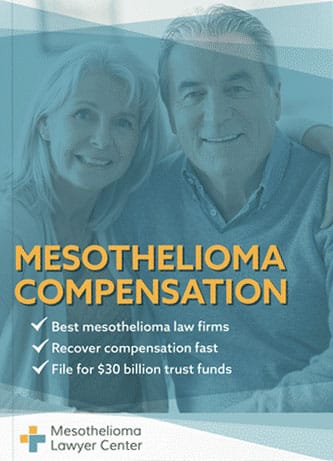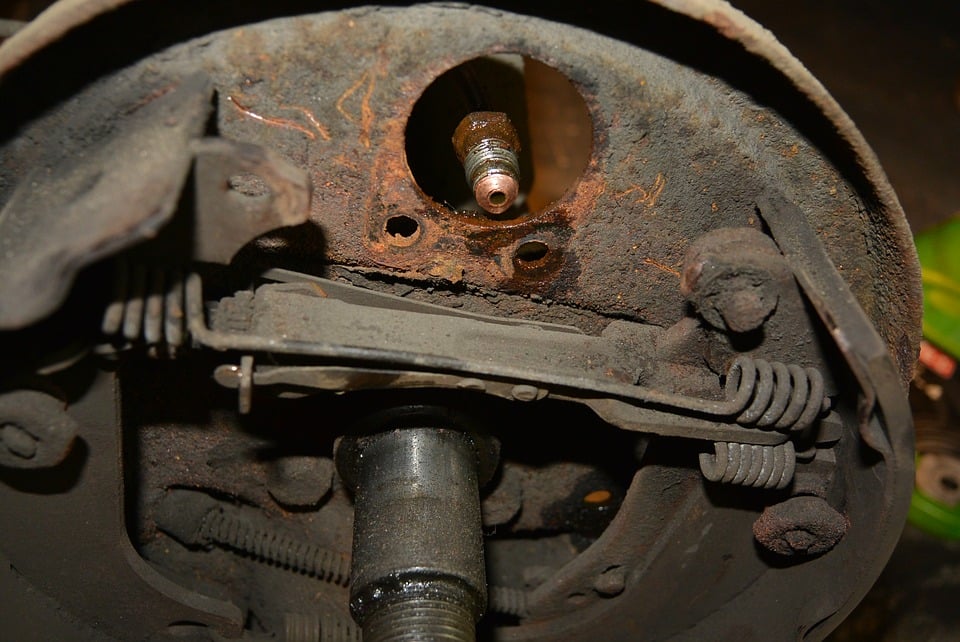Auto mechanics have a higher risk of asbestos exposure and resulting illnesses due to the use of asbestos in certain automotive parts, like brakes and clutches. The risk is lower today, but some parts still contain asbestos. Some mechanics who developed asbestos illness have sued car parts manufacturers for damages.
If you or a loved one have been diagnosed with mesothelioma, asbestos-related lung cancer, or asbestosis, you may be eligible for substantial compensation. Fill out our form to receive our free Financial Compensation Packet. Our packet is loaded with information on experienced mesothelioma attorneys in your area, how to file a claim for asbestos trust funds, how to get paid in 90 days, and more.


FREE Financial Compensation Packet
- Info on law firms that will recover your HIGHEST COMPENSATION
- Learn how to get paid in 90 days
- File for your share of $30 billion in trust funds

Are Auto Mechanics Exposed to Asbestos?
Asbestos is an efficient insulator, which makes it useful for many applications. Asbestos was used in many industries in the 1900s, including automotive manufacturing. Today, asbestos is rarely used but lingers in older materials.
Auto mechanics working on vehicles in the past had high risks of asbestos exposure. Asbestos was used in several car parts but posed the most significant risk in clutches and brakes that produced a lot of harmful dust.
Mechanics today can still be exposed to asbestos through older car parts and imported aftermarket parts. Home mechanics and hobbyists are also at risk of asbestos exposure.
What Auto Products Contain Asbestos?
During peak asbestos use in auto parts in the 1970s, the U.S. Environmental Protection Agency (EPA) reported that brake linings contained between 33% and 75% asbestos.
Asbestos is not used today to the same extent as before the EPA began regulating it. However, asbestos can still be found in some auto parts. This is especially true of older cars, specifically vehicles manufactured before the early 1980s. Asbestos was most prevalent in these automotive parts:
- Brakes. Asbestos in brakes can be particularly dangerous due to the brake lining wearing down through use, which can release asbestos fibers into the air. Fibers can also build up in the dust between the brake drums.
- Clutches. Like brakes, asbestos fibers in clutches become disturbed during normal friction and wear and tear.
- Automobile Hood Liners. Hood liners insulate and prevent cars from catching on fire. They once contained asbestos.
- Gaskets and seals. Gaskets and seals help reduce leaks in automobiles but may contain asbestos in older cars.
Other automotive parts that contained asbestos in the past include:
- Electrical insulation
- Fiberglass body components
- Transmission housings
- Heat shields
- Air conditioning housings
- Undercoatings
- Soundproofing materials
- Adhesives and body putty
Who Is at Risk of Exposure to Automotive Asbestos Products?
In the past, workers in facilities that manufactured asbestos car parts and installed them on vehicle assembly lines faced risks of asbestos exposure. Also at risk were mechanics who removed and repaired asbestos parts.
Today, mechanics remain at risk of exposure to asbestos in older and aftermarket car parts. Professional mechanics risk exposure to asbestos, but so do home mechanics. Hobbyists working on older cars and people who maintain their own vehicles can still be exposed to asbestos in car parts.
How Are Mechanics Exposed to Asbestos?
Asbestos exposure in any industry occurs when workers unintentionally inhale or ingest asbestos fibers. Asbestos materials readily shed tiny fibers that become part of the dust in the air and on surfaces. The more easily an asbestos product sheds fibers, the more dangerous it is for workers.
Automotive parts made with asbestos degrade with time and use, releasing asbestos dust that exposes workers. Mechanics are also exposed by their work, removing and cleaning asbestos drum brakes, for instance. These activities release more asbestos fibers.
Asbestos fibers in the body are harmful because they cause tissue damage that can lead to illness over time. Not everyone exposed to asbestos will get sick, but all are at risk for diseases like malignant mesothelioma, asbestosis, and asbestos lung cancer.
Some of the many ways auto mechanics were and still could be exposed to asbestos include:
- Dusting the assembly area
- Spraying down dust
- Using a vacuum not strong enough to remove tiny asbestos fibers
- Failing to wear proper protection when working with brakes, gaskets, clutches, etc.
- Cleaning drum brakes with compressed air
Since asbestos fibers are small and light, they tend to permeate the air around workers (typically up to 80 feet). Mechanics who directly handle asbestos products are not the only ones at risk of exposure. Anyone working in the area can also be exposed.
Do Automotive Parts Still Contain Asbestos?
Asbestos is not entirely banned in the U.S. and can still be found in vehicles. Automotive manufacturers in the U.S. do not use asbestos in their products today. Mechanics remain at risk of exposure to asbestos in older cars and parts.
Mechanics can also be at risk today from asbestos in imported, aftermarket car parts. These asbestos components are not banned in the U.S. Car parts from India and China are especially likely to contain asbestos.
Manufacturers That Made Asbestos Auto Products
In the past, many companies made or distributed asbestos automotive parts. Some of the companies shut down when the EPA placed strict regulations on asbestos use. Other companies, still in business, are facing asbestos lawsuits after numerous workers filed claims.
These are some of the many companies known to have manufactured or sold automotive asbestos parts:
- Abex Corporation
- Advance Auto Parts
- Austin Auto Parts Inc.
- Auto Zone
- Bendix Corporation
- Borg-Warner
- Canton Auto Parts Inc.
- Dana Corporation
- Fisher Auto Parts
- Ford Motor Company
- Garlock Sealing Technologies
- General Motors
- Genuine Auto Parts
- Globe Foreign Auto Parts
- Johns Manville
- LAS Replacement Parts
- O’Reilly Automotive
- Pep Boys
- Potsdam Auto Parts
- Raymark/Raybestos
- Ren Auto Parts
- Scanlon’s Auto Parts
- Uniroyal
Asbestos Illnesses in Automotive Mechanics
Anyone who worked with or around asbestos materials has an increased risk of developing an asbestos illness. These illnesses often do not develop until decades after initial asbestos exposure. Mechanics who handled asbestos products years ago could still be diagnosed today.
Research shows that mechanics are at risk for mesothelioma and other asbestos illnesses. One study from 2000 looked at the content of dust from six auto mechanic shops in different states. The study found asbestos in most of the samples taken, indicating that workers in the shops were at risk of exposure and illness.
A study from 2018 measured the risk more directly. Researchers looked at pleural and peritoneal mesothelioma diagnoses in hundreds of brake mechanics in the U.S. and other countries. The results show that mechanics are at high risk for exposure and resulting illness.
Asbestos Safety Guidelines for Auto Mechanics
The EPA created a comprehensive brochure for auto mechanics detailing how to stay as safe as possible when working around asbestos.
The following safety recommendations are the key components:
- Only use a Negative-Pressure Enclosure/HEPA Vacuum System Method when dusting off brakes and clutches.
- Use only low-pressure, wet cleaning methods with low-pressure spray equipment designed specifically to prevent dust from becoming airborne.
- Never take your work clothes inside your home. Second-hand asbestos exposure can occur when you go to your home wearing dirty work clothes.
- Assume all auto parts have asbestos, as it’s not detectable by the human eye. Always protect yourself with the appropriate breathing mask and other safety gear.
- Do not bring work tools home without cleaning them thoroughly with hot, soapy water.
- Use ready-to-install parts.
Asbestos Lawsuits Involving Mechanics
Many workers in a range of industries were negligently exposed to asbestos. Some of these workers got sick and sued the companies that failed to protect them from harmful asbestos. These are examples of asbestos lawsuits brought by mechanics:
- Jerry Coogan worked as a mechanic handling asbestos parts made or distributed by various companies. He was diagnosed with mesothelioma and died at the age of 67. Coogan’s widow sued asbestos car part manufacturers and distributors, winning an $81.5 million jury award. After appeals, the Washington Supreme Court upheld the jury decision.
- Bill Trokey worked on Ford brakes during his career as a mechanic. He developed mesothelioma later. Trokey and his wife sued Ford and were awarded $20 million by a Missouri jury after showing evidence that Ford knew of the risks of asbestos exposure.
- Tomas Sorrentino worked as a mechanic, replacing clutches and brakes in Volkswagen vehicles. After dying from mesothelioma in 2021, his family sued the car company. They received a $5.75 million award from a jury in Washington.
How Mechanics Can Seek Compensation for Asbestos Exposure
Contact a mesothelioma lawyer if you worked as a mechanic or worked with old cars and now have an asbestos illness. They can help you take legal action to seek compensation.
An experienced asbestos attorney has the resources necessary to investigate your past exposure. They can review your work history and any car parts you used at home to find all the possible companies liable for damages.
Depending on the companies involved, you could be eligible for a claim with an asbestos trust fund or to file an asbestos lawsuit.
Additional Help and Resources for Asbestos Victims
If you’ve been injured by asbestos, keep in mind that there is a good chance that you’ll qualify for considerable compensation. Remember to fill out our form for your free Financial Compensation Packet, with information on asbestos and mesothelioma lawyers in your area. If you have questions or need additional assistance, contact us at 800-793-4540.

Paul Danziger
Reviewer and EditorPaul Danziger grew up in Houston, Texas and earned a law degree from Northwestern University School of Law in Chicago. For over 25 years years he has focused on representing mesothelioma cancer victims and others hurt by asbestos exposure. Paul and his law firm have represented thousands of people diagnosed with mesothelioma, asbestosis, and lung cancer, recovering significant compensation for injured clients. Every client is extremely important to Paul and he will take every call from clients who want to speak with him. Paul and his law firm handle mesothelioma cases throughout the United States.
References
- Carley, L. (n.d.). Asbestos Brake Dust Still a Hazard. AA1Car.
Retrieved from: http://www.aa1car.com/library/trtu796.htm - U.S. Environmental Protection Agency. (2020, December). Risk Evaluation for Asbestos Part I: Chrysotile Asbestos.
Retrieved from: https://nepis.epa.gov/Exe/ZyPDF.cgi/P1010LB8.PDF?Dockey=P1010LB8.PDF - U.S. Environmental Protection Agency. (2023, October 24). Current Best Practices for Preventing Asbestos Exposure Among Brake and Clutch Repair Workers.
Retrieved from: https://www.epa.gov/asbestos/current-best-practices-preventing-asbestos-exposure-among-brake-and-clutch-repair-workers-1 - Fisher, D. (2014, May 6). Secrecy Crumbling as Judge Gives Ford, Insurers Access to Asbestos Files. Forbes.
Retrieved from: https://www.forbes.com/sites/danielfisher/2014/05/06/secrecy-crumbling-as-judge-gives-ford-insurers-access-to-asbestos-files/#82ac3423a604 - Kanarek, M.S. and Anderson, H.A. (2018). Mesothelioma from Asbestos Exposure in Brake Mechanics: Epidemiology in Context. Epidemiology: Open Access. 8(2), DOI: 10.4172/2161-1165.1000340.
Retrieved from: https://www.omicsonline.org/open-access/mesothelioma-from-asbestos-exposure-in-brake-mechanics-epidemiology-in-context-2161-1165-1000340.pdf - Deseret News. (2000, November 16). Auto Mechanics Are Exposed to Asbestos, Study Finds.
Retrieved from: https://www.deseret.com/2000/11/16/19539426/auto-mechanics-are-exposed-to-asbestos-study-finds - O’Brien, J. (2021, July 13). Verdict is Massive But Not Unfair, Washington Supreme Court Finds in $81M Case. Legal Newsline.
Retrieved from: https://legalnewsline.com/stories/605734838-verdict-is-massive-but-not-unfair-washington-supreme-court-finds-in-81m-case - Siegel, D. (2022, March 10). Ford Hit With $20M Verdict In Missouri Asbestos Trial. Courtroom View Network.
Retrieved from: https://blog.cvn.com/breaking-ford-hit-with-20m-verdict-in-missouri-asbestos-trial - BusinessWire. (2022, December 21). Volkswagen Group of America and Volkswagen AG Found Liable for the Mesothelioma Death of Spokane Man; Ordered to Pay $5.75 Million in Damages.
Retrieved from: https://www.businesswire.com/news/home/20221221005150/en/Volkswagen-Group-of-America-and-Volkswagen-AG-Found-Liable-for-the-Mesothelioma-Death-of-Spokane-Man-Ordered-to-Pay-5.75-Million-in-Damages
